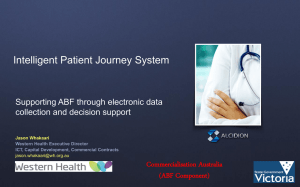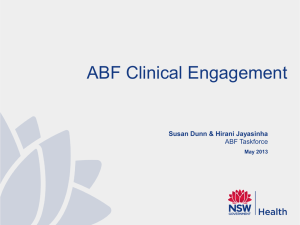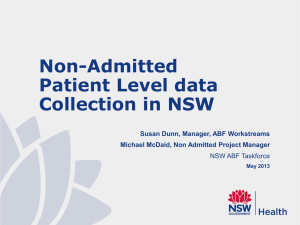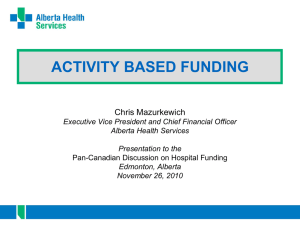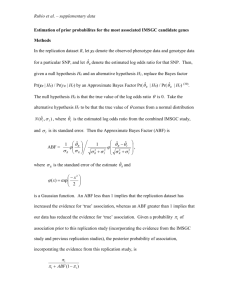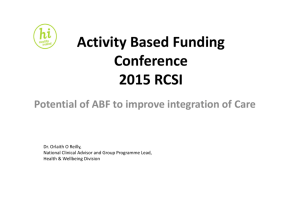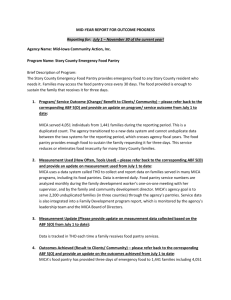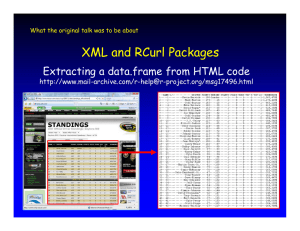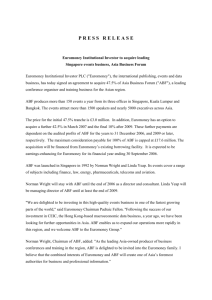HRT1123-LatestDevelopments-ABF-QH-Perspective
advertisement
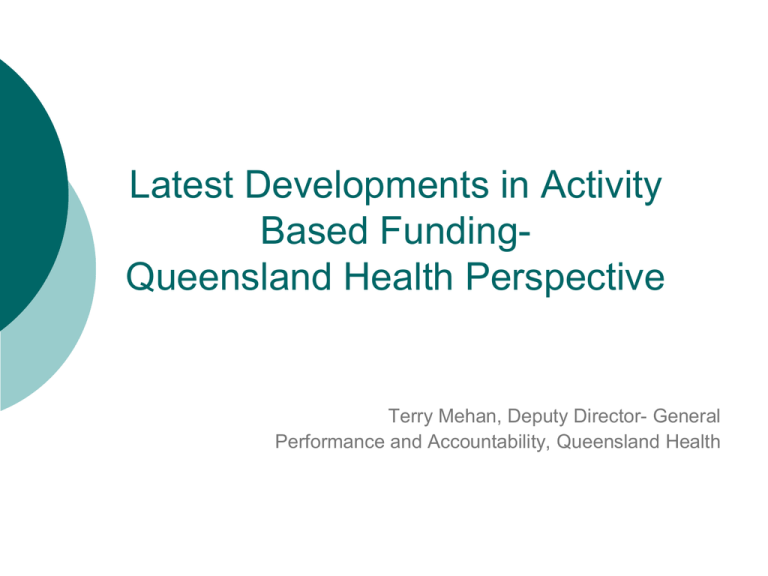
Latest Developments in Activity Based FundingQueensland Health Perspective Terry Mehan, Deputy Director- General Performance and Accountability, Queensland Health Presentation will cover: • Update on latest developments in Queensland Health in respect of: - Project Governance ABF Framework - 3 principal areas of work ie: Policy Purchasing Funding ABF Project Governance • • DDG Performance and Accountability is the Project Sponsor Sponsor supported by ABF Project Board established in March 2011 to: - - • • Provide strategic advice and recommendations to EMT on the development, implementation and management of ABF in QH Oversee completion of the development and implementation of an ABF model for QH. Board functions: business assurance, monitoring progress, risk management, stakeholder engagement, organisational change, transition back to business as usual Board membership: DDGs (FPL, PandA, CHI, PS&R), DCEOs (GC & Cairns), CFO representative, Clinical Senate representatives (Executive and Member) ABF Framework - three pillars Smarter Choices, Better Care Vision Policy Purchasing Model District Funding Tool Policy directions that aim to meet patient and community needs, taking into account population-based health service planning Implementation Purchasing of health care services to deliver the greatest benefits to patients and populations within available resources Funding District Health Services on this basis and, in particular, funding Queensland Health hospitals based on the cost of health care services (referred to as ‘activities’) delivered ABF Policy ABF Benefits • Safety & quality • Performance management • Fairer access Transparency & accountability • Allocative, technical and dynamic efficiency • • Development of ABF Policy Framework progressing through ABF Board • PS&R has proposed a number of areas for initial focus eg. activity targets, phasing out of transition payments, adjusting cost weights for cost effectiveness in improving health outcomes, incentives for patient safety and quality, funding of non-public patients, funding small hospitals Purchasing Framework • • • • • • Contracting & procurement as mechanisms to deliver improved health care services for Queensland Purchasing cycle to be based on effective health needs assessment Specifying outcomes not inputs Balancing incentives and interventions Purchasing framework now incorporated into Draft QH Compliance Framework Elements in 2011/12: Relative utilisation; Adverse events; Clinical capability; Ambulatory service model; Potentially avoidable and out of scope admissions; Modality; Own source revenue; Indexed activity Funding Tool • • • • • • Districts have received income statements calculated on activity for model and purchasing elements . No actual adjustment for relative utilisation and clinical capability Activity targets being loaded into DSS; reporting will reflect activity targets as well as revenue Short term Review Panels being established (ABF Model, Purchasing Framework, Peer Group (costing methodologies) & Site Specific Grants) Elements recently allocated to Business Owners for stakeholder engagement, formulation & approval process to Board and then EMT Technical and Operational Statewide Network being re-established Where to from here? • • • Need to ‘road-test’, evaluate and develop policy, purchasing and funding model Program planning for ABF implementation emphasises a clinician led approach Robust arrangements for communication & engagement being developed Useful Links & Addresses • ABF Website http://abf.health.qld.gov.au/ • Draft Operating Manual (on ABF website) http://abf.health.qld.gov.au/ABF/Details/125 • ABF online learning modules can be access on the finance network site or through link on ABF intranet site • Ernst and Young ABF Model Report and Coding, Costing and Counting audit reports are available at: http://casemix.health.qld.gov.au/CFM/QABFProgram.html • Any enquiries can be directed to: QABFM@health.qld.gov.au
